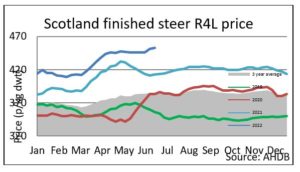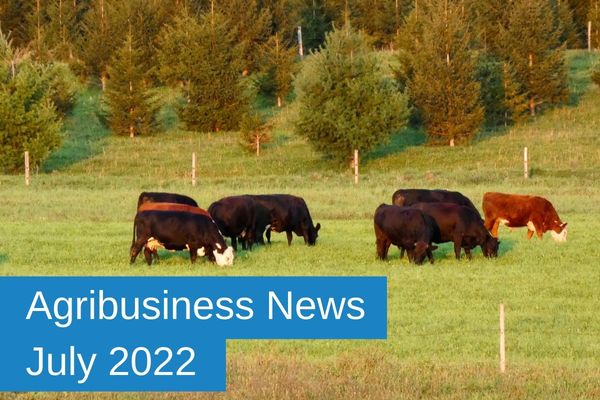Agribusiness News July 2022: Beef
30 June 2022A welcome lift in prices
The finished beef price has lifted in June to 453p/kg deadweight, a lift of around 8p from May. A tightening in numbers coming forward will have played a part in this. With most finishers concerned about margins with the high feed costs this lift in price will be welcome but may not be enough to fully compensate for the increased input costs. Breakeven prices for finishers are estimated to be in the region of 470-500p/kg. Whilst there is a reluctance in the trade for the price to lift much more, availability of cattle and consumer demand will ultimately decide where the price will settle.
The cull cow trade lifted again in June to 405p with some quotes around 410p/kg deadweight. The continued demand for manufacturing beef and less cull cows currently available has created a good bit of competition. In most years, the cow availability starts to increase as we head into the autumn, with scanning and housing, with this increase in numbers the price tends to dip so if there are still cows out there ready to kill, get them away at this high trade.
Store Cattle – Keep them mooving!
In line with the time of year, the numbers of stores being traded has dropped dramatically and those being sold have experienced a drop in value compared to this time last year of around 5%. If the beef price does not lift much more, it may be that finishers either will not restock at the same level and so demand may drop on these stores, or they may try to pay less for the stores to try to restore some of their margins lost due to the increase in feed prices.
There is an anticipation that more stores and weaned calves will be forward for sale this autumn as breeders look to reduce their wintering expenses. Whilst short keep cattle look to remain a good trade, there is a concern that some of the lighter stores with a lengthy finishing period ahead of them may drop in value at the end of the year.
Farmers with some of these lighter cattle would be advised to keep them moving and ensuring good weights for age to maintain a reasonable trade on them.
Cow numbers in decline?
Data from QMS and BCMS shows that suckler cow numbers in Scotland have declined by 2.5% from 2018-2021. This is a long term trend from the 1990’s and it is expected that further reductions in cow numbers will occur over the next year with the pressures on herd profitability from increased input prices and high cull cow values.
Around the World – Beef from Brazil
While cow numbers in Scotland are in decline, the Brazilian beef exporters association (ABIEC) released its beef report for 2022 which states it is looking to increase beef production by 35% by 2030. This would involve an increase in the kill number of over 8 million cattle from 2021 to 2031. The report states that this increase is required to meet domestic and export demand (39% of beef exported from Brazil goes to China).
The report also lays out a plan to increase productivity in the beef sector in Brazil through increasing intensity of grazing and increasing carcase weights.
Worryingly, reports from Brazil’s institute for space research show that deforestation of the Amazon rainforest for the first four months of the year was 1,954km2, an increase of 69% on the first four months of 2021. This highlights the difference in a Country and it’s Governments’ priorities in terms of agriculture and climate.
lesley.wylie@sac.co.uk , 01307 464033

For more up to date market info, see the latest edition of Agribusiness News
Sign up to the FAS newsletter
Receive updates on news, events and publications from Scotland’s Farm Advisory Service


